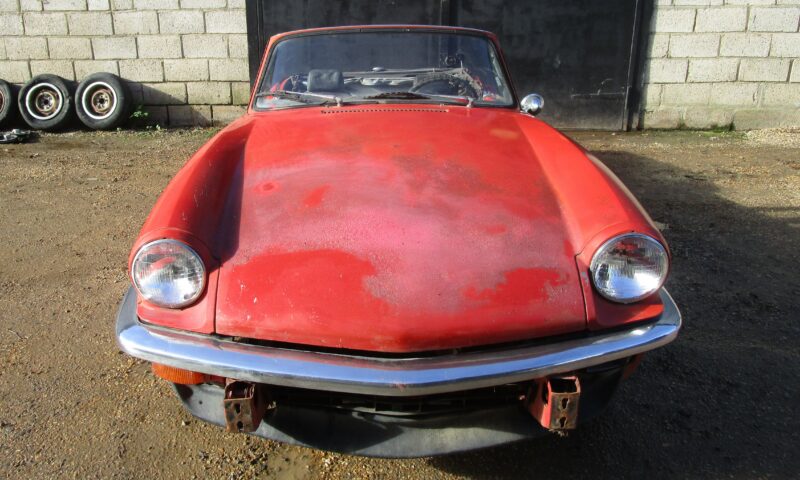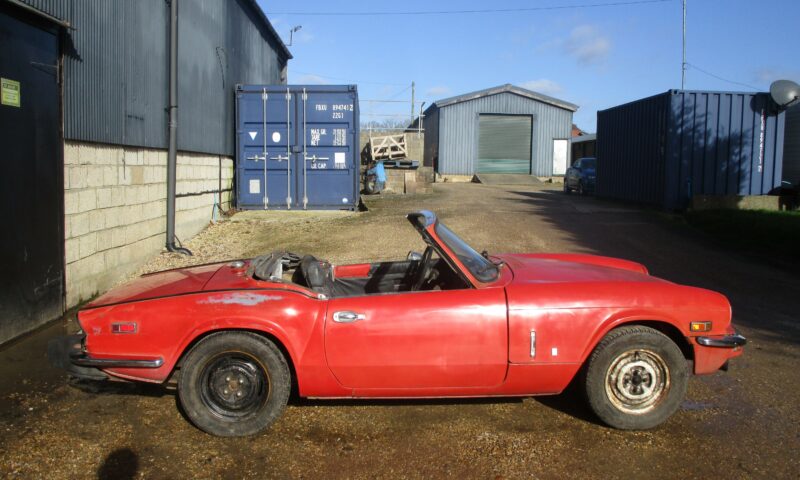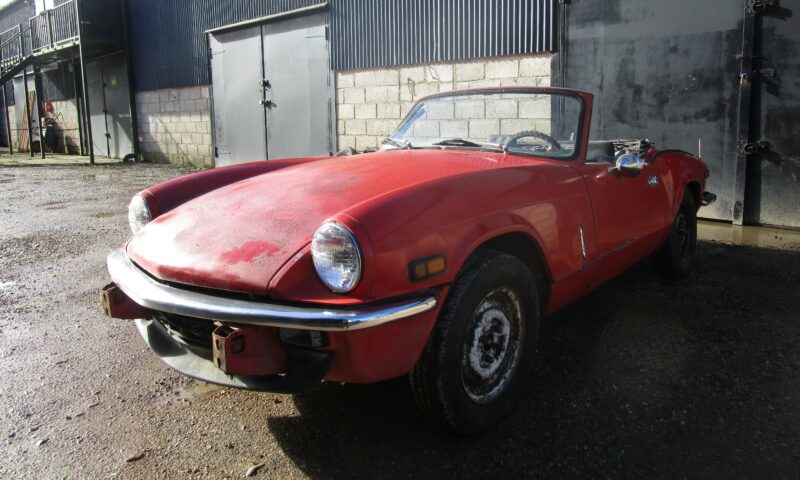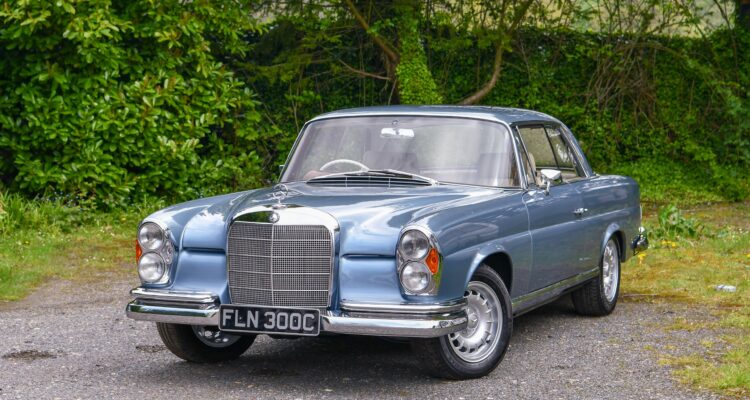1977 Triumph Spitfire 1500 – Project Profile
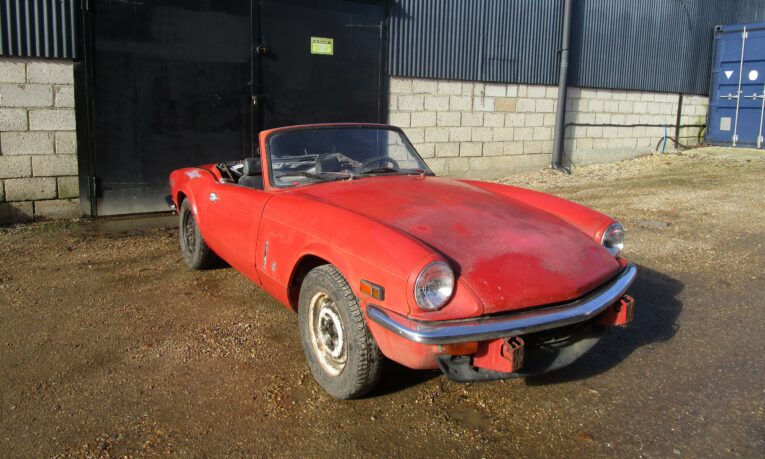
If there were ever two names to instil a sense of unbridled patriotism and pride in bygone eras of Great British manufacturing then “Triumph” and “Spitfire” are surely top contenders. From its first forays into building motorcycles back at the turn of the 20th Century, to famous celebrity endorsees (we’re looking at you Mr McQueen), Triumph has been a brand we proudly associate with well-made and sought after British cars (like this Spitfire 1500, for example) and bikes. And while it no longer makes the former it remains a widely respected manufacturer of the latter. We know, we have one. The connotations that the name Spitfire evokes are clearly obvious too and the marketing team at Triumph struck gold when it decided to name its new sports car after the legendary World War Two fighter back in 1962.
If you do label your new model with the same moniker as that most famous and distinguished of aviation idols then you better make damn sure it’s a good one. Thankfully that was exactly the case and Triumph’s new, Italian-designed two-seater was an immediate success and remains a perennially appreciated classic today with legions of fans the world over. Penned by Giovanni Michelotti (who would go on to work with Triumph on numerous models) the car was built upon a shortened version of the previous Herald chassis but with a new, separate body whilst retaining that same car’s running gear and drivetrain.
What is it?
For all our talk of nationalist honour the car we have available via our classifieds is, in fact, a US-spec, late model Triumph Spitfire 1500 having been exported there, we assume, from the factory. This means that the car is a left hooker, which is no big deal. It also means that it’s a solid example and largely rust-free, judging by the pictures attached to the ad, as it has been living happily in a dry state, unexposed to the famed British climate and salty roads. Recently imported back to the UK all taxes and duty have been paid on this 1977, low-mileage example, but despite its lack of face to face with any inclement weather there is still work to be done.
Why is it a project?
Although it is being sold as a rust-free, running example (with an external fuel feed we hasten to add), this particular Spitfire 1500 appears to have been sitting for a while which means it will require a full mechanical overhaul as well as a complete strip and repaint. The interior is also in a pretty sorry state too and so will need to be fully refreshed, from carpets to seats. The major selling point here is the lack of rot and the good news is that parts are readily available, so let’s take a closer look, shall we?
Five things to look for:
1) Bodywork and chassis
As stated, the bodywork looks pretty clean but it’s still worth inspecting all of the panels thoroughly. Being a bolt-on affair it isn’t the end of the world, however, if any need replacing. It’s way more important to ensure that the chassis is in good shape and free from accident damage or shoddy repair work. Check for corrosion too. The outriggers underneath the bulkhead can rot, as can the bottom of the bulkhead itself, along with the rails at the rear end around the differential.
2) Engine
The US 1500s, despite benefiting from a larger capacity version of Triumph’s four-cylinder, were down on power compared to their UK counterparts thanks to a Zenith-Stromberg carburettor and a reduced compression ratio in order to lower emissions. It remains a simple affair though and is a reliable unit if correctly maintained. Check for smoke and rattles, indicative of pistons and rings that have seen better days. A full rebuild compared to a complete replacement is much of a muchness, financially speaking, so bear this in mind if it’s a particularly tired unit. Crankshafts on these engines are also prone to wear so check for rough running.
3) Suspension and steering
All of this is a simple affair on the Spitfire and any repairs or replacement parts are inexpensive. Having said that it’s still worth inspecting the rubber bushings, anti roll bar links and wheel bearings. The Lower trunnions need regular lubrication too so check that this has indeed been the case. If you can, get the car in the air and test for any play wherever parts join. Seeing as it’s likely to be stripped it might be worth replacing the whole lot for peace of mind. While the 1500s benefit from improved rear suspension the car in question does sit a little lower in the rear which could be caused by sagging leaf springs.
4) Interior
This Spitfire 1500 will need a full interior as part of any restoration work. Again, parts are readily available and a doddle to fit but it might be worth considering some simple upgrades while you’re at it to improve any of the Triumph’s inherent interior shortcomings. Check the condition of the roof too. Is it salvageable or does it need to be replaced?
5) Paperwork
There is little mention of any documentation with this Spitfire, aside from the NOVA paperwork, which means it can be successfully registered here in the UK. Check with the seller to see if any additional service and maintenance records are supplied with the car. If it’s going to be restored and mechanically overhauled then it isn’t a huge issue but it would still be handy to know the car’s history.
What should you do with it?
It may be a tad rough but this particular Triumph Spitfire 1500 looks like a solid example and would make a great base for a full restoration. With some choice upgrades and a properly refreshed and tuned motor it could be back to its Great British B-road blasting best fairly easily thanks to the excellent support and parts supply that is available for these cars. If you’re bothered about which side you sit a RHD conversion would be a simple affair too, so what are you waiting for?


